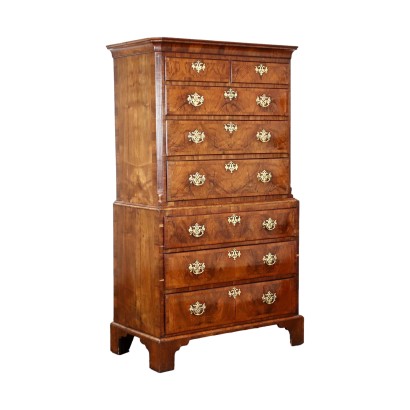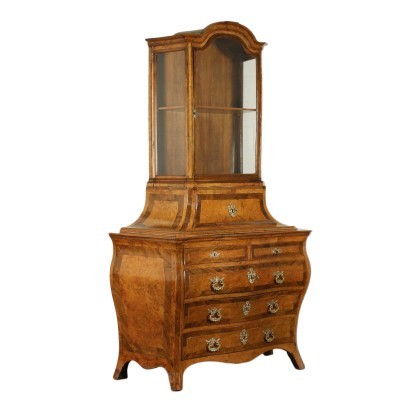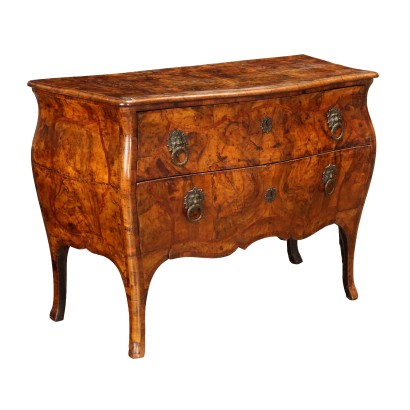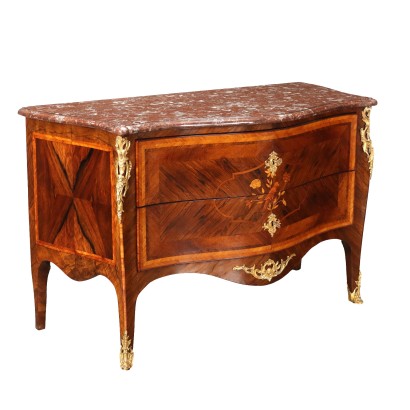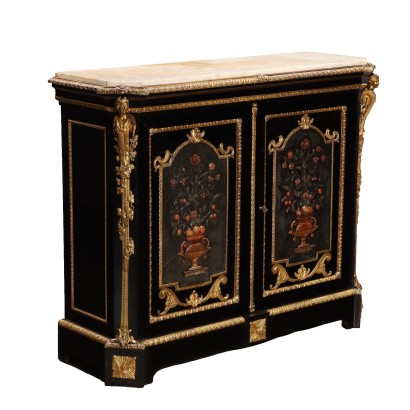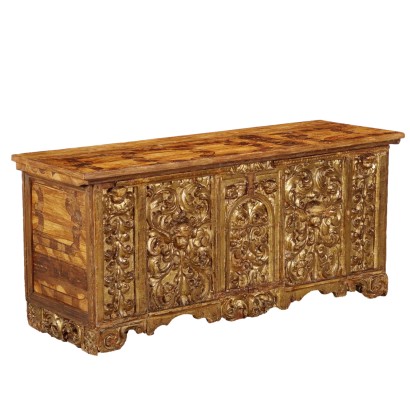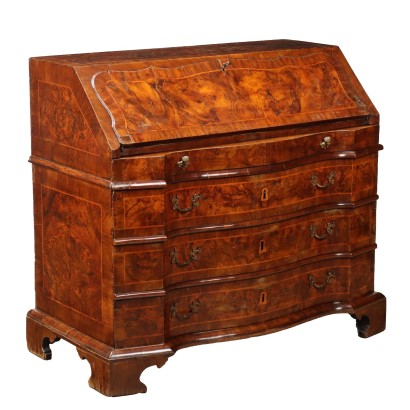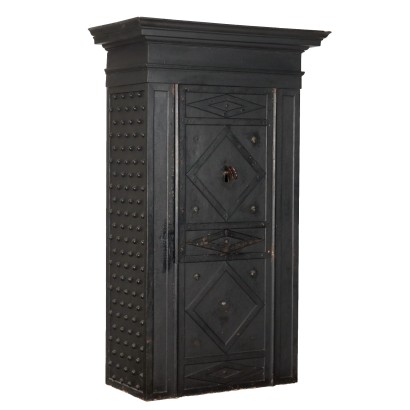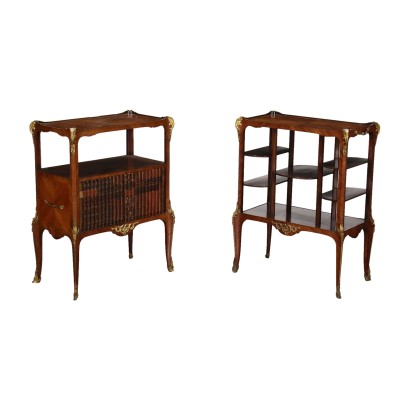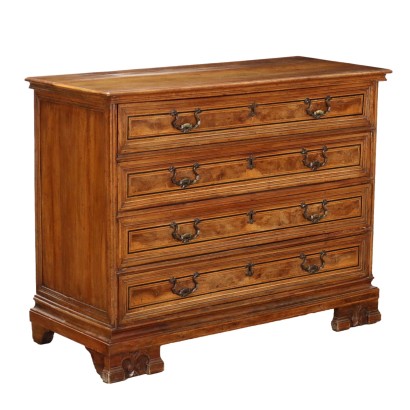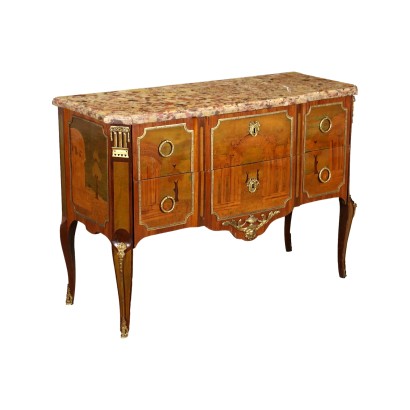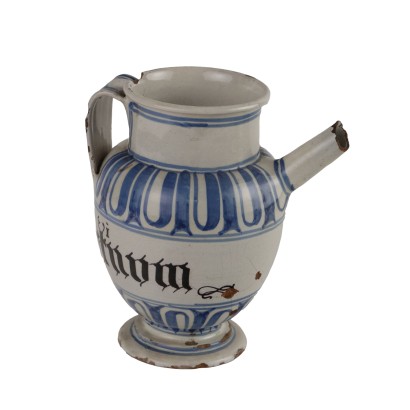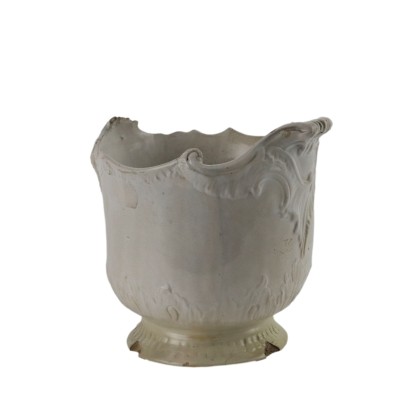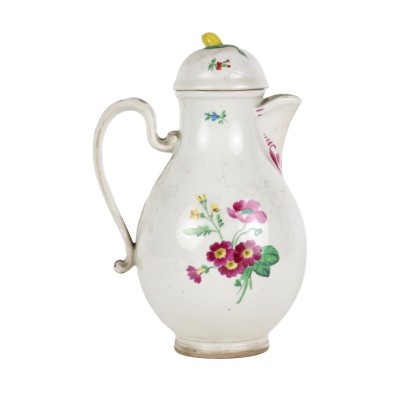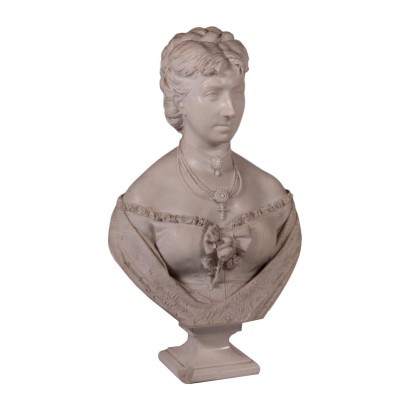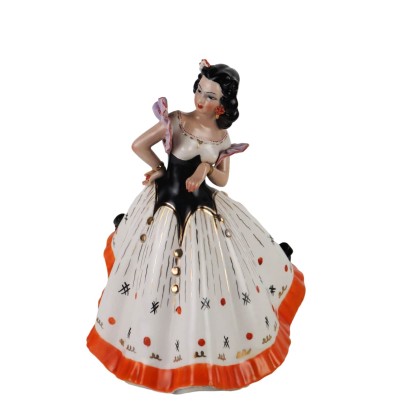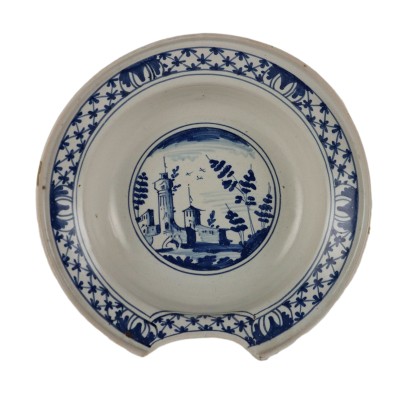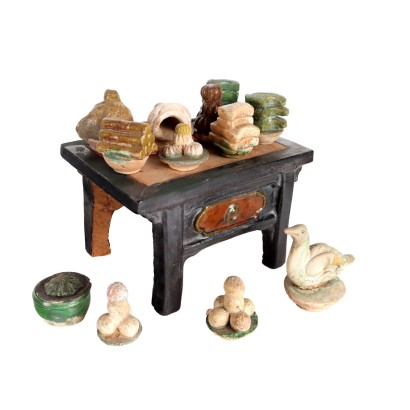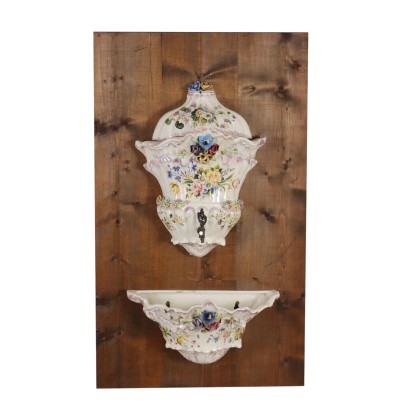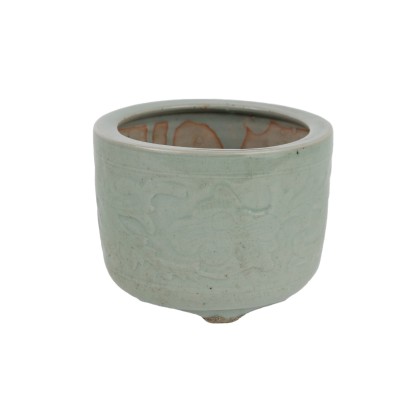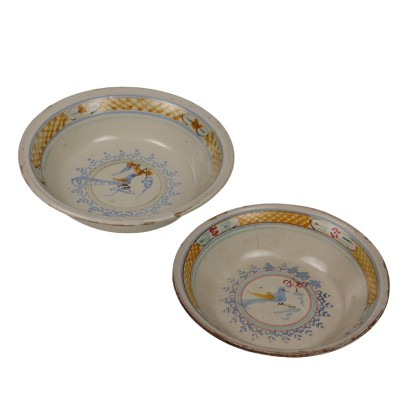Antique Tallboy George II Walnut Oak Great Britain XVIII Century
Features
Style: George II (1730-1760)
Age: 18th Century / 1701 - 1800
Origin: England
Description
Tallboy supported by carved shelf feet, in the lower body it has three drawers plus the same number in the upper body, surmounted by two other small side-by-side drawers; the uprights of the upper part are at 45 ° and carved with a tapered pattern. Entirely veneered in briar of walnut, it has characteristic vents and handles in gilded brass bronze; oak interior.
Product Condition:
Product in good condition, with small signs of wear.
Dimensions (cm):
Height: 185
Width: 108
Depth: 56
Additional Information
Notes historical bibliographic
This piece of furniture, used as a linen chest of drawers, was made in about 1730, finding full confirmation with the shapes used in the Georgian period. It is a high quality piece of furniture, entirely veneered in walnut briar to create a refined pictorial effect. If the oak interiors are a feature that will also be found in subsequent eras, the use of walnut in English furniture is a peculiarity characteristic of the late seventeenth, first half of the eighteenth century, while from the second half of the century it will be increasingly replaced by mahogany, essence imported from the colonies, until its complete replacement in the nineteenth century.Style: George II (1730-1760)
It is part of the so-called "Georgian" period.This term designates the stylistic activity that took place in England between 1714 and 1830 and included the reigns of George I, George II, George III and George IV.
It is characterized, at its beginnings, by an attitude of reaction to the Baroque.
Precise characteristics and distinctions of this style are not clearly identifiable in the furniture created in England in the eighteenth century.
In the first half of this century, cabinetmaking and the products of the various categories of English applied art were affected by the continuous changes in taste and manifested, in the diversity of trends and influences, the uncertainty of a precise stylistic orientation.
The sensibility and exceptional ingenuity of four strong personalities, destined to guide the English taste and customs of the time, intervened in the second half of the eighteenth century to make well-defined choices: Th. Chippendale, R. Adam, G. Hepplewhite and Th. Sheraton.
Find out more with our insights:
FineArt: Tallboy George II, England c.1730
FineArt: Pair of Irish Mirrors, in George III Style, second half of the 19th century
Age: 18th Century / 1701 - 1800
18th Century / 1701 - 1800Main essence:
Walnut
Walnut wood comes from the plant whose botanical name is juglans regia , probably originally from the East but very common in Europe. Light or dark brown in color, it is a hard wood with a beautiful grain, widely used in antique furniture. It was the main essence in Italy throughout the Renaissance and later had a good diffusion in Europe, especially in England, until the advent of mahogany. It was used for solid wood furniture and sometimes carvings and inlays, its only big limitation is that it suffers a lot from woodworm. In France it was widely used more than anything else in the provinces. In the second half of the eighteenth century its use decreased significantly because mahogany and other exotic woods were preferred.Oak
Under the name of oak or oak various types of woods derived from plants of the genus quercus are grouped. They are always resistant, hard and compact woods. Oak is lighter than oak, both are used for more rustic furniture or for the interiors of French and English antique furniture. In other processes it was gradually replaced by the advent of exotic woods considered more valuable since the 18th century.Other customers have searched:
Cassettiera, cassettone, settimanale, mobile da camera, commode, canterano, comò..
Approfondimenti
Scopri di più su cassettiere e comò grazie ai nostri approfondimenti:
La storia nascosta in due antichi cassettoni
Conoscere il Neoclassicismo attraverso un cassettone piacentino
Un comò piemontese influenzato dal fascino per l'Oriente
Un signorile comò rococò napoletano
Una caratteristica cassettiera con alzata emiliana di perfetto gusto barocchetto
E per gli appassionati dal gusto più raffinato, c'è FineArt:
Commode a tre cassetti G.B.M., inizio XIX secolo
Canterano dipinto
Canterano emiliano, primo quarto XVIII
Cassettone a ribalta romano, secondo quarto XVIII secolo
Comò attribuito a Luigi Viglione, Luigi XVI, fine XVIII, Torino
Coppia di comò e comodino di Maggiolini
Sull'antiquariato in generale dai un'occhiata anche a
Classic Monday: da un pezzo dei nostri magazzini alla storia dell'antiquariato
L'antiquariato dalla A alla Z: il Dizionario dell'Antiquariato
Il dizionario dell'antiquariato - Lastronatura
Il dizionario dell'antiquariato - Mascherone
Il dizionario dell'antiquariato - Natura morta
Il dizionario dell'antiquariato - Opificio
Il dizionario dell'antiquariato - Pastiglia
Il dizionario dell'antiquariato - Savonarola
Il dizionario dell'antiquariato - Rosone
Approfondimenti
Scopri di più su cassettiere e comò grazie ai nostri approfondimenti:La storia nascosta in due antichi cassettoni
Conoscere il Neoclassicismo attraverso un cassettone piacentino
Un comò piemontese influenzato dal fascino per l'Oriente
Un signorile comò rococò napoletano
Una caratteristica cassettiera con alzata emiliana di perfetto gusto barocchetto
E per gli appassionati dal gusto più raffinato, c'è FineArt:
Commode a tre cassetti G.B.M., inizio XIX secolo
Canterano dipinto
Canterano emiliano, primo quarto XVIII
Cassettone a ribalta romano, secondo quarto XVIII secolo
Comò attribuito a Luigi Viglione, Luigi XVI, fine XVIII, Torino
Coppia di comò e comodino di Maggiolini
Sull'antiquariato in generale dai un'occhiata anche a
Classic Monday: da un pezzo dei nostri magazzini alla storia dell'antiquariato
L'antiquariato dalla A alla Z: il Dizionario dell'Antiquariato
Il dizionario dell'antiquariato - Lastronatura
Il dizionario dell'antiquariato - Mascherone
Il dizionario dell'antiquariato - Natura morta
Il dizionario dell'antiquariato - Opificio
Il dizionario dell'antiquariato - Pastiglia
Il dizionario dell'antiquariato - Savonarola
Il dizionario dell'antiquariato - Rosone
Alternative proposals
It could also interest you



